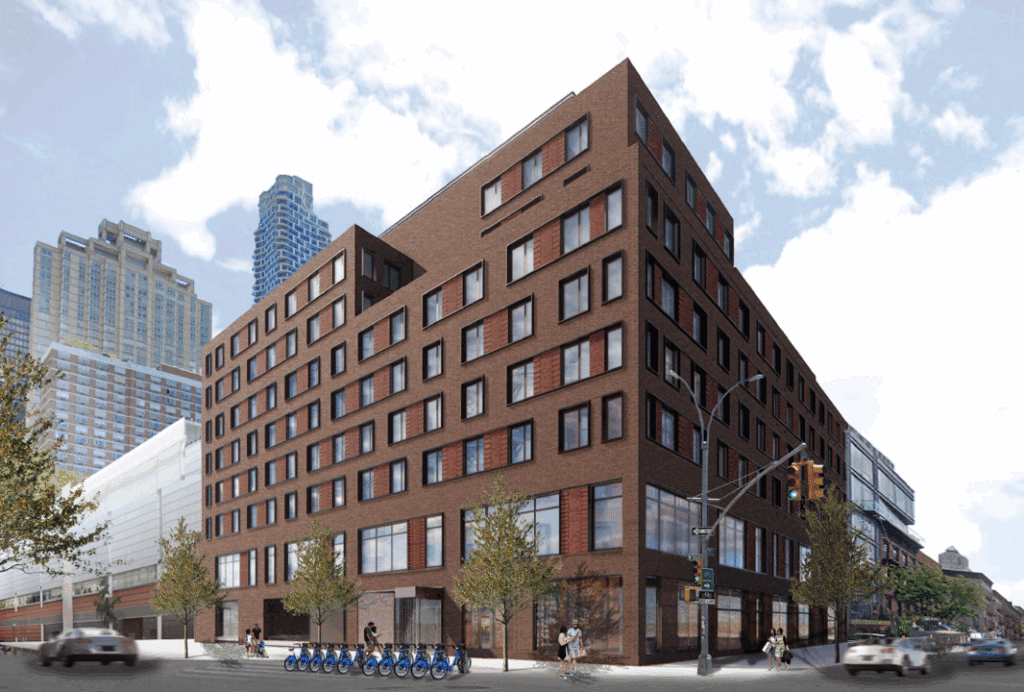HIV/AIDS Survivors Will Find a Place to Live in New York City

By Mark Fogarty
6 min read

A giant tulip tree in the New York City borough of Queens is the oldest living organism in the city. The tree (Liriodendron tulipifera) has given its name to The Lirio, a space for those who have weathered the HIV/AIDS crisis.
With a recent topping-out ceremony, The Lirio is nearing completion. The Lirio will comprise 112 units of affordable housing, an office for the New York City Metropolitan Transit Authority (MTA), and retail space in the challenging Manhattan neighborhood of Hell’s Kitchen, according to co-developer Hudson Companies. (Housing Works is the other developer.)
Hudson Companies notes that with the city’s highest concentration of residents living with HIV and one of the highest rates of new infections, “The Lirio will provide 67 units of supportive housing for formerly homeless individuals, of which 59 units will be targeted for long-term survivors of HIV/AIDS. The Lirio will also include 44 units of much-needed permanently affordable housing for families.”
As first reported by Crain’s, the public/private financing package of $119 million includes a $62 million construction loan from Webster Bank, more than $22 million in Low Income Housing Tax Credits through Red Stone Equity Partners, and approximately $19 million in a permanent loan from Merchants Capital. Public funding, which supports some of the elements at The Lirio, includes a subsidy from the Department of Housing Preservation and Development (HPD) and funding from Councilmember Erik Bottcher and Manhattan Borough President Mark Levine.
According to Brian McFarland, principal of the project architect CetraRuddy, the project’s Passive House status is a significant component.
In an interesting detail, the Passive House component “only applies to the residential portion of the building,” he says, and not to the non-residential part, which includes 30,000 square feet of office space for the MTA adjacent to its Rail Control System facility, and “a relatively small retail component on the ground floor facing Ninth Avenue.”
The Passive House status encompasses the entry lobby on the ground floor and the apartments on the third through ninth floors.
“I’m not sure this has ever been done before,” McFarland says, which may present a replicability challenge for other developers.

Lobby Is Passive House
The Passive House envelope “is not just the skin and the roof but includes the bottom of the residential building. It also penetrates down to the residential lobby,” he says. (The MTA has a separate entrance and elevators.)
Design challenges also arose on the mixed-use floors.
“The MTA required a secure facility. The MTA portion of the building is “blast-enclosed,” designed to protect the center from bad actors,” says McFarland. “So that’s another level of separation.” Walls separating the center from retail are also blast-enclosed, he says.
Yet another separation between the MTA and the housing is the Malkovitch Floor, a three-foot interstitial space between the two components (see sidebar).
In other design aspects, the third floor serves as a counseling center for residents, administered by Housing Works. Additionally, the floor features a lounge and a workspace with computer stations.
“Even though it’s available to all residents of the building, it’s really focused on counseling for the supportive housing portion of the building, which is designed to house survivors of the original AIDs epidemic from the mid to late 1980s,” says McFarland.
A large corridor on the floor also leads to a central amenity: a spacious, landscaped outdoor recreation area. The building has a U shape, and the interior of the U will be utilized for outdoor activities. This space is essentially built on top of the MTA portion of the building.
Other amenities feature a rooftop garden, fitness center, bicycle storage, and 24-hour front desk staff. Completion is expected in 2027.
How did CetraRuddy design a living space for HIV/AIDS survivors? They utilized a Single Room Occupancy (SRO) model.
“It’s very supportive housing,” says McFarland. “When we designed this building, HPD had design standards for SRO units. They’re small studio-efficiency apartments. It’s one living-sleeping space. They each have their own bathroom and a limited all-electric kitchen.”
Advertisement
A Few Challenges
The Passive House component was challenging.
“The intent was always for the architecture to be at home in the Clinton/Hell’s Kitchen neighborhood. It’s a brick masonry building for the most part with punched windows.”
The windows are triple-glazed vinyl, making them perform better in thermal transfer.
McFarland states that the most significant factors in achieving Passive House status are substantial improvements in the thermal envelope’s performance, ensuring the envelope is sealed, and mechanically ventilating each room in the building.
According to McFarland, the Lirio presented a particular challenge because it is located in a special zoning district, which includes a height restriction.
The building was designed to be space-efficient by utilizing unused air rights at the MTA’s transit control facility. This approach enabled a one-third expansion of the building, and, according to the architect, facilitated the planning of approximately 40 additional apartments.
At the topping-out ceremony on April 22, David Kramer, president of Hudson Companies, said The Lirio, “addresses a wide range of urgent needs – supportive and affordable housing at varying income levels, MTA office space that will help modernize the subway system, and neighborhood retail, all within a sustainable building.”
He said, “The Lirio goes beyond just providing new housing; it represents a commitment to affordability, lifesaving services, and long-term community investment.”
Also at the ceremony, Andrew Coamey, senior vice president of Housing Works, said, “The topping out of The Lirio is a powerful reminder of what we can accomplish when we come together to build a more inclusive city. The Lirio will be life-changing for individuals experiencing homelessness and people living with HIV/AIDS, offering them the foundation to rebuild and thrive.”
Other partners involved in the project are EP Engineering, DeSimone Consulting Engineers, and Bright Power.
Actor Malkovich Inspires Architectural Component
Filmgoers of the movie “Becoming John Malkovich” were amused by its depiction of the miniature Floor 7 1/2, whose occupants had to bend over to fit into its half-space. But in a case of life imitating art, The Lirio has a three-foot “Malkovich Floor” that separates the Passive House apartments from the non-passive mixed-use component below them.
The Lirio’s principal architect, Brian McFarland of CetraRuddy, notes, “We have 112 units, so we have at least 112 bathrooms and 112 kitchens, and a lot of pipes are coming down from that. So, what we’re doing in that three-foot-tall floor between the MTA and the residential building is collecting a lot of the vertical plumbing stacks in that space, so we have a limited number of stacks that go down through the MTA space. That was the real challenge between the MTA and residential buildings.”
Plumbing is concentrated horizontally in the interstitial space and consolidated into only six to eight stacks of drainage pipes, which continue downward, resulting in a tight fit.
“I do feel bad for any plumber who has to go in there and do any work,” McFarland says.